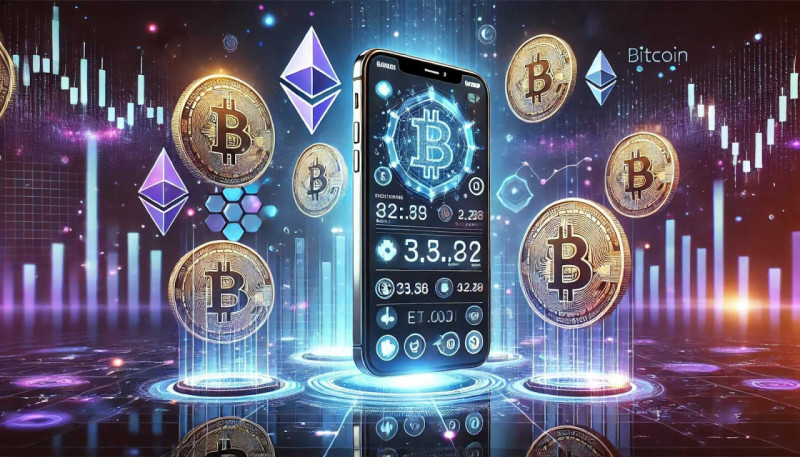
Introduction
Cryptocurrency mining has gained massive attention in recent years as digital currencies like Bitcoin and Ethereum continue to surge in popularity. Mining is the process by which new cryptocurrency tokens are created and transactions are verified across decentralized networks. Traditionally, this process requires substantial computing power, often carried out on powerful desktop setups or specialized mining rigs. However, as technology advances, users are increasingly exploring whether it’s possible to mine cryptocurrency on mobile devices like iPhones. For those new to the world of digital currencies, it’s essential to understand not just mining, but also how to buy cryptocurrency for beginners, as buying crypto is often the first step in engaging with this evolving financial landscape.
The idea of mining cryptocurrency on an iPhone is appealing to many for its convenience and accessibility. With millions of iPhone users worldwide, the potential for mobile mining has sparked curiosity among both tech enthusiasts and cryptocurrency newcomers. But is it really feasible to mine cryptocurrency using just your smartphone? This article dives into the possibility of mobile mining, especially on iPhones, and explores the available methods, apps, and alternatives.
By the end of this guide, you’ll have a clear understanding of how to mine cryptocurrency on iPhone, the limitations and risks involved, and whether mobile mining is a practical or profitable option. Let’s explore the current state of cryptocurrency mining on iPhones and discover the best approach for those interested in getting started.
What Is Cryptocurrency Mining?
Cryptocurrency mining is the process by which new cryptocurrency tokens are generated and transactions are verified on a blockchain network. At its core, mining ensures the security and decentralization of a blockchain, allowing the network to remain operational without a central authority. Miners, or the individuals who participate in this process, are crucial to maintaining the integrity of cryptocurrency transactions.
The Role of Mining in Blockchain Networks
Blockchain networks, such as those used by Bitcoin and Ethereum, are decentralized systems where transactions occur without the need for intermediaries like banks or governments. For the network to function securely and transparently, transactions must be verified and recorded in a way that prevents fraud, such as double-spending or tampering with previous records. This is where miners come in. They use their computational power to solve complex mathematical puzzles, and when a puzzle is solved, the transactions within a block are validated and added to the blockchain.
In exchange for this work, miners are rewarded with newly created cryptocurrency tokens, hence the term "mining." This process also ensures that the supply of new tokens follows a predictable rate, with rewards often decreasing over time in a process called "halving," as seen with Bitcoin.
Proof of Work (PoW) and Its Role in Mining
Cryptocurrency mining is most commonly associated with a consensus mechanism called Proof of Work (PoW). PoW is a protocol that requires miners to solve complex cryptographic puzzles, which are computationally intensive, in order to add a new block to the blockchain. Solving these puzzles requires substantial computing power and energy, making it costly in terms of both hardware and electricity. This makes tampering with the blockchain very difficult, as any attacker would need to control a majority of the network’s computing power, which is extremely expensive.
The process works as follows:
- Miners use their computers to compete in solving a mathematical puzzle.
- The first miner to solve the puzzle gets the right to add a new block of transactions to the blockchain.
- In return, the miner receives a block reward in the form of newly minted cryptocurrency.
The Proof of Work system is designed to be resource-intensive on purpose, ensuring that bad actors cannot easily manipulate the blockchain. This system has been a key factor in the success of cryptocurrencies like Bitcoin, but it also comes with significant challenges.
Hardware and Energy Requirements for Traditional Mining
Mining cryptocurrencies like Bitcoin requires specialized hardware known as ASICs (Application-Specific Integrated Circuits), which are specifically designed for this purpose. For Ethereum and some other cryptocurrencies, miners use powerful GPUs (Graphics Processing Units). These machines consume vast amounts of energy and generate a lot of heat, making mining a costly endeavor both in terms of hardware investment and electricity consumption.
In fact, the energy consumption of cryptocurrency mining has sparked debates about its environmental impact, as large-scale mining operations can use as much electricity as entire countries. This is one of the reasons why mining on traditional devices like desktop PCs or dedicated hardware rigs is typically more efficient than attempting to mine on mobile devices like iPhones.
Mining Different Cryptocurrencies: Bitcoin, Ethereum, and Monero
Not all cryptocurrencies are mined in the same way. For example, Bitcoin and Ethereum both use Proof of Work, but they require different types of hardware. Bitcoin mining is heavily reliant on ASICs, making it nearly impossible to mine with standard consumer hardware. Ethereum, while still benefiting from GPUs, is transitioning away from PoW to a more energy-efficient consensus mechanism called Proof of Stake (PoS), where miners, or validators, are chosen based on the amount of cryptocurrency they hold rather than their computing power.
On the other hand, privacy-focused cryptocurrencies like Monero are designed to be mined using CPUs (central processing units), which are found in everyday devices, including smartphones. This makes Monero one of the few cryptocurrencies that, in theory, could be mined on an iPhone. However, even in this case, the limited computing power of an iPhone compared to dedicated mining hardware makes it unlikely that mobile mining would be profitable or efficient.
Cryptocurrency mining plays a critical role in maintaining blockchain networks by verifying transactions and securing the system against fraud. Proof of Work, the most common consensus mechanism, requires substantial hardware and energy resources, making mining a resource-intensive process. While different cryptocurrencies have unique mining requirements, most demand hardware that exceeds the capabilities of mobile devices like iPhones, making traditional mining on smartphones impractical for the majority of users.

Can You Mine Cryptocurrency on an iPhone?
The idea of mining cryptocurrency on an iPhone might seem intriguing at first, given the sheer convenience of using a mobile device that’s always within reach. However, the technical and practical limitations of mining on an iPhone quickly become apparent. Mining cryptocurrency is a resource-intensive process that typically requires high-performance hardware, and iPhones—though powerful in their own right—aren't designed for such demanding tasks. Moreover, Apple has placed specific restrictions on mining apps in the App Store, further complicating the prospect of mobile mining.
Apple’s App Store Restrictions on Mining Apps
One of the biggest roadblocks to mining cryptocurrency on an iPhone is Apple's strict policy against it. In 2018, Apple updated its App Store guidelines to explicitly ban cryptocurrency mining apps. The updated policy reads:
«Apps may not mine for cryptocurrencies unless the processing is performed off the device (e.g., cloud-based mining)»
This restriction was put in place primarily to protect iPhone users from the significant energy and performance strain that mining apps can impose on their devices. Cryptocurrency mining, especially on small-scale consumer devices like smartphones, can overwork the processor, drain battery life, and generate excess heat, all of which can degrade the performance and longevity of the device.
By prohibiting mining apps, Apple effectively prevents iPhone users from running processes that could compromise the usability of their devices. While this restriction may disappoint those hoping to mine directly on their iPhones, it underscores the technical limitations of mobile mining and Apple's commitment to maintaining device integrity.
Hardware Constraints: Performance, Battery Life, and Heat Generation
Even without Apple’s restrictions, mining cryptocurrency on an iPhone would still be highly impractical due to hardware limitations. The most crucial factor in cryptocurrency mining is computational power. As mentioned in previous sections, mining involves solving complex mathematical puzzles through a consensus mechanism known as Proof of Work (PoW). This process is extremely demanding on hardware, typically requiring high-end GPUs or dedicated ASICs (Application-Specific Integrated Circuits) to be profitable or even feasible.
iPhones, though highly optimized for everyday apps and multitasking, lack the computational power necessary for effective mining. Attempting to mine on an iPhone could lead to several issues, such as:
- Excessive battery drain
Mining is energy-intensive, and iPhone batteries are not built to handle the continuous, power-hungry computations required for cryptocurrency mining. - Overheating
Running a mining operation on an iPhone would cause the device to generate significant heat, which could damage internal components over time. - Degraded performance
The constant use of processing power for mining could slow down other essential functions on the phone, making it less responsive for regular use.
In short, even if it were possible to mine cryptocurrency on an iPhone without violating Apple’s policies, the hardware constraints would make it an inefficient and potentially harmful activity for the device.
Computational Power Required vs. iPhone Capabilities
To understand why mining on an iPhone is impractical, it’s important to compare the computational power needed for effective mining with what an iPhone can offer. As discussed, cryptocurrency mining relies on solving complex puzzles to verify transactions and add new blocks to the blockchain. In the case of Bitcoin, for example, the difficulty of these puzzles has increased dramatically over the years, making it virtually impossible for anyone without dedicated hardware to compete with large mining farms.
The performance capabilities of an iPhone, though impressive for mobile devices, fall far short of the requirements for competitive mining. Even older cryptocurrencies that allow for CPU mining, such as Monero, would still require far more computing power than an iPhone can provide efficiently. As a result, any attempt to mine cryptocurrency on an iPhone would likely yield negligible profits while risking significant wear and tear on the device.
Alternative Approaches: Cloud Mining and Reward Apps
Given the restrictions and hardware limitations, iPhone users looking to get involved in cryptocurrency mining have turned to alternative methods, such as cloud mining or reward apps.
- Cloud Mining
Cloud mining allows users to rent the computational power of remote servers, which do the actual mining. This approach means that none of the processing is done on the user’s iPhone, which mitigates concerns about device performance, heat, or battery life. Many cloud mining services offer mobile-friendly platforms that iPhone users can access through apps or browsers, making it a viable solution for those who still want to participate in mining without the hardware requirements. - Reward Apps
Instead of directly mining cryptocurrency, some apps allow iPhone users to earn crypto by performing tasks like watching ads, completing surveys, or participating in social media activities. While these apps don’t involve mining, they provide a way for users to earn small amounts of cryptocurrency without the technical challenges of running mining software.
Both cloud mining and reward apps offer iPhone users a way to engage with cryptocurrency without running afoul of Apple’s restrictions or overtaxing their devices.
While the idea of mining cryptocurrency on an iPhone might sound appealing, the technical challenges and Apple’s restrictions make it an impractical endeavor. The hardware constraints of an iPhone, combined with the energy demands of mining, render it unsuitable for the task. However, alternatives such as cloud mining and reward apps provide accessible ways for iPhone users to participate in the cryptocurrency ecosystem without compromising their devices. For those interested in learning how to mine cryptocurrency on iPhone, the answer lies in exploring these alternative solutions rather than traditional mining approaches.

Cryptocurrency Mining Apps on iPhone: Fact or Fiction?
With the growing interest in cryptocurrencies, many iPhone users are exploring ways to participate in mining directly from their mobile devices. Several apps have emerged that claim to offer cryptocurrency mining capabilities. However, most of these apps don't mine cryptocurrency in the traditional sense. Instead, they provide rewards in the form of cryptocurrency for completing tasks, participating in social networks, or staking. To clarify what these apps actually offer, let's review some popular options like Pi Network, Electroneum, and other similar apps that claim to offer crypto-earning opportunities.
Pi Network: Mining or Just Earning?
One of the most popular apps that claims to mine cryptocurrency on mobile devices is Pi Network. Pi Network allows users to earn its native cryptocurrency, Pi, by simply pressing a button once a day to "mine." However, it’s important to note that Pi Network doesn't involve real mining in the traditional Proof of Work (PoW) sense.
Unlike Bitcoin or Ethereum, where mining requires high computational power to solve complex algorithms, Pi Network operates on a different concept. Instead of using the processing power of your iPhone, Pi Network engages its users in a decentralized social network where active participation (such as inviting others) allows you to earn Pi tokens. The app doesn’t use any significant processing power from your phone, which means there's no drain on your battery or impact on your phone's performance.
Currently, Pi is not listed on any exchanges, meaning its value is speculative. The app essentially offers a reward system for engagement, but this is far from traditional mining, where valuable cryptocurrencies like Bitcoin or Ethereum are earned through computational work. As such, Pi Network’s claim of mobile mining is more of a social interaction and marketing strategy than actual cryptocurrency mining.
Electroneum: The Original Mobile Mining App
Another app that initially gained attention for its mobile mining claims is Electroneum. When Electroneum launched, it touted itself as the first cryptocurrency designed specifically for mobile devices. At the time, the app allowed users to mine Electroneum tokens (ETN) using their phone’s CPU. However, like Pi Network, this wasn't "mining" in the traditional sense.
Electroneum used a process called simulated mining, which means that the app didn’t use your phone’s actual processing power to mine. Instead, it rewarded users with ETN tokens in exchange for their participation. This approach was designed to allow users to earn ETN without placing a significant strain on their device’s resources. However, as the project developed, Electroneum eventually shifted from its simulated mining approach to a more sustainable reward system that no longer emphasizes mining on mobile devices.
Today, Electroneum functions more like a rewards app, with users earning ETN through in-app activities such as participating in surveys or watching ads, rather than performing computational mining tasks. While Electroneum was innovative in its approach to mobile cryptocurrency, its original mining claims were more symbolic than actual.
Other Cryptocurrency Reward Apps
Several other apps claim to offer mining or crypto rewards for iPhone users. Examples include StormGain, CryptoTab, and Bee Network. However, like Pi Network and Electroneum, most of these apps don’t involve traditional mining. Instead, they provide alternative ways for users to earn cryptocurrency.
- CryptoTab markets itself as allowing users to mine Bitcoin while browsing. However, the mining is not done on the user’s phone but rather through a cloud service. Users earn a small share of Bitcoin based on the browsing activity, but this is more akin to a rewards program than direct mobile mining.
- Bee Network offers users a way to earn its native cryptocurrency, Bee, by pressing a button once a day. The app promotes the idea of mobile mining, but again, no real computational mining occurs. It’s essentially another form of social interaction and engagement, with the promise of future value once Bee tokens are listed on exchanges.
- StormGain offers cloud mining services, allowing users to mine cryptocurrency without using their iPhone’s resources. Users sign up and earn rewards through cloud-based servers. While this isn't true mining on the device, it provides a way for mobile users to engage in crypto-earning activities without draining their phone's battery or processing power.
Understanding Apple’s Restrictions on Mining Apps
Apple’s restrictions on cryptocurrency mining apps significantly influence the functionality of these applications. As mentioned previously, Apple prohibits apps that mine cryptocurrencies directly on the device due to concerns about battery life, performance, and heat generation. This policy ensures that iPhone users don’t experience performance degradation or hardware damage from running resource-heavy mining software.
As a result, apps that operate in the App Store must comply with these guidelines by offering alternatives to traditional mining. This means most apps either simulate mining (by rewarding users with tokens for engagement) or offer cloud mining services, where the actual mining is done off-device on remote servers. The shift toward cloud-based solutions aligns with Apple’s focus on preserving device health while still allowing users to participate in the cryptocurrency ecosystem.
The prospect of mining cryptocurrency on an iPhone is more fiction than fact. While several apps market themselves as mobile mining platforms, most of them are simply reward systems that offer tokens in exchange for participation, tasks, or social engagement rather than actual mining. Apple’s restrictions on mining apps further limit the possibility of true mining on an iPhone, steering users toward alternatives like cloud mining or simulated rewards. For those interested in learning how to mine cryptocurrency on iPhone, exploring cloud mining or staking opportunities remains the best approach.

Cloud Mining: The Best Alternative for iPhone Users
For iPhone users who are eager to get involved in cryptocurrency mining but face limitations with hardware or app restrictions, cloud mining offers a viable alternative. Cloud mining allows users to participate in the mining process without the need for powerful hardware or risking the performance of their devices. It opens the door for iPhone users to contribute to mining operations by renting remote servers dedicated to mining cryptocurrencies, making it a convenient option for mobile enthusiasts.
What Is Cloud Mining?
Cloud mining is a service that lets individuals rent the computational power of large, remote data centers to mine cryptocurrencies. Instead of owning and maintaining mining hardware (which can be expensive and requires constant electricity and cooling), users simply pay a fee to access the mining power of a remote server. These servers are typically owned by companies that specialize in cryptocurrency mining. Users can rent a portion of the mining power, often referred to as "hash power," and in return, they receive a share of the cryptocurrency mined by the data center.
For iPhone users, this means they can mine cryptocurrency without taxing their device’s resources or facing Apple’s strict App Store restrictions. Cloud mining makes the process straightforward and accessible, requiring only a mobile-optimized website or an app to manage the rented mining operations.
How Does Cloud Mining Work for iPhone Users?
Cloud mining services are easy to access via mobile devices, including iPhones. Users can sign up for a cloud mining service through an app or by visiting the provider’s website. The typical steps to get started with cloud mining on an iPhone are as follows:
- Step 1: Choose a Cloud Mining Provider
Start by selecting a reputable cloud mining provider, such as HashFlare, Genesis Mining, or StormGain. Make sure the provider has a mobile-friendly platform or a dedicated app that works well on iPhones. - Step 2: Create an Account
Register for an account on the provider’s platform. This process is usually straightforward, requiring basic information such as an email address and password. - Step 3: Choose a Mining Contract
Cloud mining services offer various contracts, typically based on the cryptocurrency you want to mine (e.g., Bitcoin, Ethereum) and the amount of hash power you want to rent. Some contracts are short-term, while others last for months or even years. - Step 4: Pay for the Contract
Cloud mining typically requires an upfront payment, which covers the cost of renting the mining equipment and electricity usage. Many providers offer flexible payment options, including credit cards and cryptocurrencies. - Step 5: Start Earning
Once the contract is in place, you can monitor your mining progress through the app or website. As the rented servers mine cryptocurrency, you will receive a share of the profits based on the amount of hash power you purchased.
Pros and Cons of Cloud Mining
Like any investment or service, cloud mining has its advantages and disadvantages. Here’s what iPhone users should consider before diving into cloud mining:
Pros:
- No Need for Expensive Hardware
With cloud mining, there’s no need to buy or maintain expensive mining equipment. All the computational work is done remotely, making it ideal for mobile users who want to participate without owning mining rigs. - Energy Efficiency
Cloud mining eliminates concerns about energy consumption and overheating, which can be major issues for those trying to mine on their own hardware. Since the mining process happens in a data center, users don’t have to worry about electricity bills or damaging their devices. - Convenience
Cloud mining platforms are accessible through mobile apps or websites, making it easy to monitor earnings and manage mining contracts directly from an iPhone.
Cons:
- Upfront Costs
Cloud mining often requires a significant upfront investment, as users need to pay for the mining contract in advance. Additionally, the profits from cloud mining may be slower to accumulate compared to direct hardware mining. - Profitability Risks
Cloud mining returns depend on various factors, such as cryptocurrency market prices, network difficulty, and the mining provider’s efficiency. There is no guarantee of profitability, and in some cases, the fees associated with cloud mining may outweigh potential earnings. - Trustworthiness of Providers
The biggest risk with cloud mining is choosing a reputable service provider. Some cloud mining services have been exposed as scams, so it’s crucial to do thorough research before committing to a contract. Users should look for transparent providers with proven track records and customer reviews.
Subscription Fees and Revenue Sharing
Cloud mining typically involves paying subscription fees or buying mining contracts based on the hash power required. Most cloud mining providers operate on a revenue-sharing model, where the user’s earnings are proportional to the amount of hash power rented. Providers take a percentage of the earnings to cover operational costs, and the remaining profit is distributed to users.
For iPhone users learning how to mine cryptocurrency on iPhone, it’s important to understand that cloud mining profits are not instant. The process involves ongoing maintenance and operational fees that can reduce overall earnings, particularly during periods when cryptocurrency prices are low or network difficulty is high.
Cloud mining is a practical and efficient alternative for iPhone users who want to participate in cryptocurrency mining without the hardware requirements and energy consumption of traditional mining. By renting remote mining power, users can still earn cryptocurrency with minimal impact on their devices. While cloud mining offers convenience and accessibility, potential users must be cautious about upfront fees, profitability risks, and the importance of choosing a reputable provider. For those interested in how to mine cryptocurrency on iPhone, cloud mining represents the best option to explore.

Alternative Ways to Earn Cryptocurrency on iPhone
For iPhone users who are interested in earning cryptocurrency without engaging in traditional mining, there are several alternative methods that are mobile-friendly, easy to use, and don’t require the heavy computational power typically associated with mining. These methods allow users to accumulate cryptocurrency through tasks, staking, or reward programs, making it accessible to almost anyone with a smartphone.
Mobile-Friendly Crypto Earning Methods
There are several popular methods for earning cryptocurrency on an iPhone that are accessible and do not require any mining. These include staking, cashback rewards, and faucets, each offering different ways to earn small amounts of cryptocurrency.
| Method | Description | Potential Returns |
| Staking | Users lock up their cryptocurrency in a wallet for a period of time to help secure the network and validate transactions. In return, they earn rewards. | Can offer moderate to high returns depending on the amount staked and the staking platform used. |
| Cashback Rewards | Apps or services that offer cashback in cryptocurrency for purchases made through their platforms, such as using a debit or credit card linked to the app. | Returns vary based on spending activity but typically offer small percentages (e.g., 1-5%) in crypto rewards. |
| Crypto Faucets | Websites or apps that give away small amounts of cryptocurrency in exchange for completing simple tasks like captchas, quizzes, or viewing ads. | Returns are usually very small but consistent over time. |
Apps Offering Cryptocurrency for Tasks
There are many apps designed for iPhone users that offer cryptocurrency in exchange for completing tasks. These tasks can range from taking surveys, watching ads, or performing microtasks. While the returns are relatively small, they are easy ways to accumulate cryptocurrency with minimal effort.
- Brave Browser — Offers rewards in Basic Attention Token (BAT) for viewing ads.
- StormGain — Allows users to earn cryptocurrency through trading and cloud mining features.
- Sweatcoin — Converts physical steps into a digital currency that can be exchanged for products or services, though it may eventually offer crypto-based rewards.
These apps provide an easy entry point for users who want to learn how to mine cryptocurrency on iPhone without engaging in traditional mining. While the earnings are modest, they are an effective way to start accumulating cryptocurrency in a low-risk environment.
Potential Returns Compared to Mining
The returns from these alternative methods are typically much lower than those from traditional mining or cloud mining. However, they come with fewer risks and lower upfront costs. Staking, for example, can offer higher returns over time depending on the amount staked, while cashback rewards and faucets provide a steady stream of small, consistent earnings. These methods are ideal for users who want to build their cryptocurrency holdings gradually, without the need for specialized hardware or the risks associated with direct mining.
Conclusion
Mining cryptocurrency on an iPhone may seem like an appealing idea, but the practical challenges make it an unrealistic option. The hardware limitations of iPhones, combined with Apple’s strict App Store policies against mining apps, create significant barriers to traditional mining. The computational power required to mine most cryptocurrencies exceeds what an iPhone can offer, leading to potential issues like overheating, battery drain, and slow performance.
However, for users still interested in earning cryptocurrency, there are viable alternatives. Cloud mining allows iPhone users to participate in the mining process by renting remote servers, avoiding the hardware strain on their devices. Additionally, task-based apps and reward programs, such as cashback offers or microtask platforms, provide accessible ways to accumulate cryptocurrency without mining. These methods are more practical and allow users to earn crypto in smaller, more consistent amounts.
For those wondering how to mine cryptocurrency on iPhone, the best approach is to explore these alternative methods rather than attempting traditional mining. Whether through cloud mining or crypto-earning apps, iPhone users can still engage with the cryptocurrency world securely and efficiently.





